
In April of 2015, Gary Herbert found himself riding to a downtown Salt Lake City hotel in a limousine with President Barack Obama, who, late in his second term, was fulfilling a pledge to visit all 50 states before leaving office. Herbert, then the governor of Utah, had been waiting a long time for the opportunity to get the president one-on-one, and there was an essential issue he wanted to discuss.
“We got to talking about immigration,” recalls Herbert, “the complex and challenging problem that it is. Obama said to me, ‘Gary, the problem is we can’t get Congress to do anything about this issue.’ And I reminded him, ‘Well, we tried to do immigration on a state basis and you sued us.”
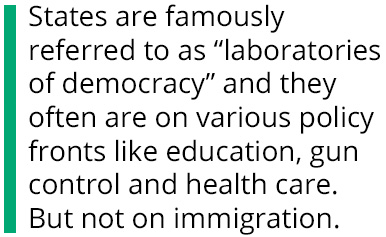 In 2011, the soft-spoken, straight-talking governor had worked closely with Utah’s legislature to write and pass a comprehensive package of immigration bills. Most noteably, the new laws created a state-administered guest worker program — and granted eligibility to undocumented immigrants who were already living in the state, offering them the chance to apply for temporary visas. The package of bills also established a pilot program that let Utahns sponsor new immigrants coming into the state, and it set up a commission to examine how to better integrate immigrants into Utah society.
In 2011, the soft-spoken, straight-talking governor had worked closely with Utah’s legislature to write and pass a comprehensive package of immigration bills. Most noteably, the new laws created a state-administered guest worker program — and granted eligibility to undocumented immigrants who were already living in the state, offering them the chance to apply for temporary visas. The package of bills also established a pilot program that let Utahns sponsor new immigrants coming into the state, and it set up a commission to examine how to better integrate immigrants into Utah society.
“We passed a law,” says Hebert, “that gave the state the right to work with immigrants that were here undocumented and help bring them out of the shadows, and treat them with respect, and have them pay taxes. If the federal government wanted to deport them, that was their prerogative, but we wanted them to know that the state of Utah was willing to work with them and help them under their circumstances.”
But the Obama administration’s win in the courts prevented the law from being implemented. While the Justice Department took particular issue with a provision that instructed state law enforcement to verify the immigration status of individuals arrested for felonies and certain misdemeanors, there were also underlying state and federal government power dynamics at play: The new laws had the potential to change the fundamentals of how the whole country approaches immigration policy, granting power to the states that is otherwise the sole domain of the federal government.
***
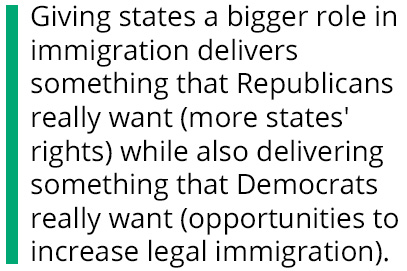 As a lifelong Republican, Herbert invokes the Federalist Papers in arguing that states should have the right to administer their own immigration programs. “In Federalist 45,” he says, “James Madison wrote, ‘The powers that we’ve given to the federal government are few and defined.’ Few and defined, that’s the enumerated powers in the Constitution to the federal government. Madison went on, ‘The powers we’ve given to the states are numerous and indefinite.’”
As a lifelong Republican, Herbert invokes the Federalist Papers in arguing that states should have the right to administer their own immigration programs. “In Federalist 45,” he says, “James Madison wrote, ‘The powers that we’ve given to the federal government are few and defined.’ Few and defined, that’s the enumerated powers in the Constitution to the federal government. Madison went on, ‘The powers we’ve given to the states are numerous and indefinite.’”
Herbert adds that Ronald Reagan famously reminded us all that, “‘Look, the federal government didn’t create the states, the states created the federal government. We’re the originators.’”
States are famously referred to as “laboratories of democracy” and they often are on various policy fronts like education, gun control and health care. But not on immigration.
This puzzles Demetrios Papademetriou, the co-founder of the Migration Policy Institute, a think tank that views immigration as a positive force if properly managed. “Making immigration decisions, going back to the end of the 19th century, it has been the exclusive domain of the federal government,” says Papademetrou, who’s been involved in immigration policy debates for nearly half a century. “And I ask, ‘Why?’”
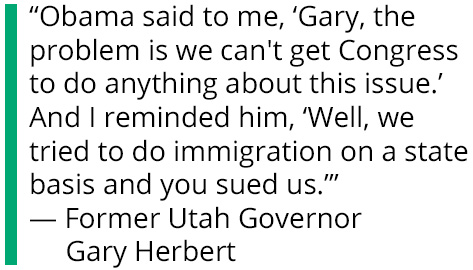 It’s a question that instantly scrambles political signals because giving states a bigger role in immigration delivers something that Republicans really want (more states’ rights) while also delivering something that Democrats really want (opportunities to increase legal immigration). Since the idea delivers on both of these fundamental pursuits no one can retreat to their traditional corners, or roll out boilerplate arguments for and against. And while the Constitution gives the federal government sole authority over the matter of “naturalization” — that is, citizenship — it doesn’t forbid states from directly administering visas, particularly on a temporary basis.
It’s a question that instantly scrambles political signals because giving states a bigger role in immigration delivers something that Republicans really want (more states’ rights) while also delivering something that Democrats really want (opportunities to increase legal immigration). Since the idea delivers on both of these fundamental pursuits no one can retreat to their traditional corners, or roll out boilerplate arguments for and against. And while the Constitution gives the federal government sole authority over the matter of “naturalization” — that is, citizenship — it doesn’t forbid states from directly administering visas, particularly on a temporary basis.
“What if,” says Papademetriou, “Washington says to every state, ‘Yeah, you can bring them on a temporary visa. These are the requirements that they have to meet. You will have three years to demonstrate that they can adjust to the circumstances: life and work in your region, your county. And during that time, the people who live in that county or region will have to demonstrate that they can embrace these people.”
Other countries have implemented similar programs, empowering specific provinces or regions to administer temporary visas to foreign nationals. Canada and Australia are prime examples, where provisions are put in place to track how successful regions are at welcoming and retaining immigrants. Some similarly long-term studies are already baked into the U.S. immigration system; when it comes to a foreign national marrying a U.S. citizen, for instance, there are follow-up interviews spread out over years that test the validity of the union.
“Every two years,” says Papademitriou, “you have a state say, ‘Well, we want another 1,500.’ So the federal government asks them, ‘What happened to those 1,500 from last year?’ ‘Well, about 1,350 left to move with their relatives in New York City.’ And so the federal government would say to them, ‘Sorry.’ We’ll give you 50. Try harder to have these people engage and become embedded, not just into the economy of your county, but also into the society of your county. Try harder.”
***
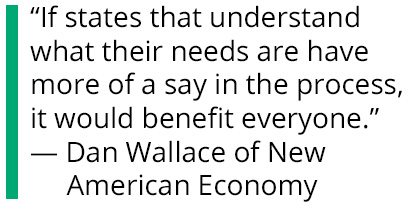 In the U.S., there are already specialized programs that do, in effect, provide ways for state and local governments to directly pursue foreign workers. The Conrad 30 Waiver Program allows foreign medical graduates of U.S. institutions to apply for a waiver that lets them skip a requirement to live outside the country for two years before getting hired. Each state gets 30 waivers so they can bring these qualified, available doctors into communities that are sorely underserved.
In the U.S., there are already specialized programs that do, in effect, provide ways for state and local governments to directly pursue foreign workers. The Conrad 30 Waiver Program allows foreign medical graduates of U.S. institutions to apply for a waiver that lets them skip a requirement to live outside the country for two years before getting hired. Each state gets 30 waivers so they can bring these qualified, available doctors into communities that are sorely underserved.
There is also the Massachusetts initiative known as Global Entrepreneur in Residence program, or Global EIR, through which universities distribute visas to entrepreneurs who simultaneously work with the school and activate a business plan within the state.
“There is no visa specifically for entrepreneurs in the U.S.,” notes Dan Wallace of New American Economy, which advocates for a more pro-immigrant policy at the federal level but also works to help cities and states develop initiatives that position communities as welcoming and inclusive to immigrants. He adds, “There are some other countries that have created visas specifically for entrepreneurs.”
Wallace says the Global EIR program recognizes that “so many folks want to come to the U.S. to start companies and create jobs and we’re turning a lot of those folks away. There are states that want to bring in more people because, specifically, they want to have a stronger entrepreneurship ecosystem. I think you can also see that other countries are experimenting and, in many cases, they’re doing a better job than we are at crafting specific ways for folks to come. I think they’re hiring people away from the U.S. … In a lot of ways we’re shooting ourselves in the foot by keeping these avenues closed. If states that understand what their needs are have more of a say in the process, it would benefit everyone.” According to the website for the Global EIR program, 42 visas have been administered since the program began in 2015, creating 123 jobs while raising $29.9 million.
The idea of empowering states on immigration already has champions on both sides of the aisle at the federal level. The presidential campaign platform of Pete Buttigieg, former Mayor of South Bend, Indiana, included a similar idea; he did not propose a state-administered program but put forward the idea of “heartland” visas (sometimes referred to as “place-based” visas) that could be available to distressed communities looking to grow their population and economy.
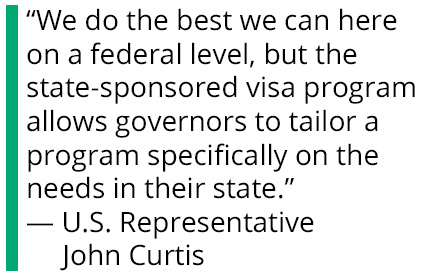 In a February 2021 congressional hearing, Zoe Lofgren, chair of the House Judiciary Subcommittee on Immigration and Citizenship and a Democrat from California, commented that heartland visas were an “interesting idea.” The statement was significant given that many Democrats at the federal level have concerns about the devolution of their authority over visas. A heartland visa program, still fully administered by the federal government, could be a palatable starting point for some. It could serve as an initial test, which could help Congress decide whether or not to scale up the role states and localities play in administering their programs.
In a February 2021 congressional hearing, Zoe Lofgren, chair of the House Judiciary Subcommittee on Immigration and Citizenship and a Democrat from California, commented that heartland visas were an “interesting idea.” The statement was significant given that many Democrats at the federal level have concerns about the devolution of their authority over visas. A heartland visa program, still fully administered by the federal government, could be a palatable starting point for some. It could serve as an initial test, which could help Congress decide whether or not to scale up the role states and localities play in administering their programs.
Another 2020 Democratic presidential candidate, Michael Bloomberg, also expressed support for heartland visas. In 2015, New American Economy, an organization that he founded, released a report analyzing Welcome Dayton, a community initiative designed by local officials in the manufacturing city to enhance “immigrant integration by encouraging business and economic development; ensuring access to education, health, and government and justices services; and promoting an appreciation of diverse arts and culture.” Over the first five years of the initiative, New American Economy found that Dayton reversed its population decline and economic downturn with a 23.2-percent increase in the foreign-born population. That growth added 200 manufacturing jobs throughout Montgomery County while bringing an estimated $115 million in spending power to Dayton — and an estimated $15 million in state and local tax revenue.
There’s also support for a state-sponsored visa program on the Republican side of the aisle. Ron Johnson, the senior U.S. senator from Wisconsin, put forward the State Sponsored Visa Pilot Program Act of 2017, which outlined the initial contours of a potential system. More recently, John Curtis, the U.S. representative for Utah’s third congressional district, introduced a nearly identical measure in the House. “At a really base level,” says Curtis, “it’s impossible on a federal level to deal with the nuances of each state. We do the best we can here on a federal level, but the state-sponsored visa program allows governors to tailor a program specifically on the needs in their state. It’s a million times easier to hold the governor accountable than your congressman, right? It gives people on the ground more control over their destiny. It holds people accountable for good and bad decisions in a way we can’t do on a federal level.”
The 2019 bill introduced by Curtis would create a system that allows states to opt out of the program if they choose to; it also allows states that opt in to customize their visa allocations based on local economies and needs. States are incentivized to comply with the program rules — especially maintaining high levels of retention. If they do a good job, additional visas are allocated the following year. If not, the allocation shrinks.
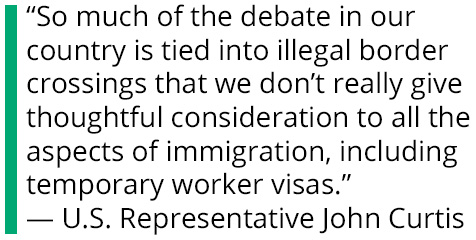 Curtis’s program would empower states to determine within limits the duration of the visas and visa holders would be required to regularly apply for renewal. The power to consider any possibility of earned permanent residency would remain with the federal government. Creating opportunities to convert some temporary workers to green card holders — that is, permanent residents — might prove vital to getting buy-in from labor, a powerful interest group for Democratic officeholders. Unions often oppose increases in visas for temporary workers, who can be hired at lower wages, and therefore look more favorably on green card holders as potential new members and long-term stakeholders.
Curtis’s program would empower states to determine within limits the duration of the visas and visa holders would be required to regularly apply for renewal. The power to consider any possibility of earned permanent residency would remain with the federal government. Creating opportunities to convert some temporary workers to green card holders — that is, permanent residents — might prove vital to getting buy-in from labor, a powerful interest group for Democratic officeholders. Unions often oppose increases in visas for temporary workers, who can be hired at lower wages, and therefore look more favorably on green card holders as potential new members and long-term stakeholders.
Under the program proposed by Curtis, the enrolling states would be guaranteed 5,000 visas with a further amount determined by population. Each state would decide who gets the visas. Wisconsin could give them to dairy workers and California could give them to coders. States would be encouraged to form regional pacts.
Curtis sees clear ways his home state would benefit from such pacts. “Nevada may be happy to allow their seasonal visa workers to come work in the state of Utah at our ski resorts,” he says. “Yet, interestingly, the stewardship would still reside with Nevada. We have very high standards in the bill for states in compliance. States have the ability — just because you’re dealing with smaller numbers — to hold these workers to compliance with the law. ”
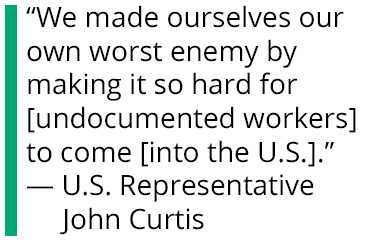 The congressman also underscores that not all migrants are looking to stay in the U.S. permanently. “In some cases these are people who would come seasonally to work,” says Curtis. “I believe — and I think there’s a lot of data to back this up — that a good number of these workers want to go back home. They come, they want to obey our laws, they want to pay taxes, they want to work, and they want to go back home.”
The congressman also underscores that not all migrants are looking to stay in the U.S. permanently. “In some cases these are people who would come seasonally to work,” says Curtis. “I believe — and I think there’s a lot of data to back this up — that a good number of these workers want to go back home. They come, they want to obey our laws, they want to pay taxes, they want to work, and they want to go back home.”
Curtis notes that before the federal government started building significant barriers at the southern border in the 1990s, many foreign workers had cyclical migration patterns, coming to the U.S. for a day or a week or a season, and then returning home. “Because they knew the next season, it wouldn’t be a problem to come back,” he says. “But if it’s a problem to come back then these workers don’t want to go home. We made ourselves our own worst enemy by making it so hard for them to come in.
“So much of the debate in our country is tied into illegal border crossings that we don’t really give thoughtful consideration to all the aspects of immigration, including temporary worker visas,” Curtis continues. “If you step back, there really is no reason that somebody should be concerned about a temporary worker visa. It’s actually hurting us as a country, that we’re not taking advantage of these resources. I hear all the time, ‘I can’t get people to do this work.’ I know that there are thousands and thousands of people willing to come to my state to work hard, to pay taxes, to obey the law, and go back home. The fact that we have failed, as a country, to line up that need with those resources really only hurts us as a country.”
The reality is that some states might choose to opt out of a program like the one Curtis has proposed, but he emphasizes that this would not reduce immigration. The proposed program is in addition to existing visa programs — it’s not meant to replace them.
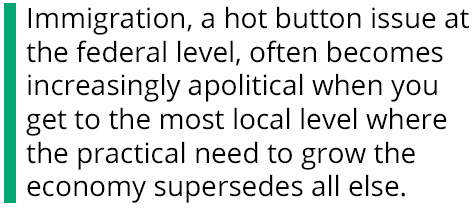
Even so, some pro-immigration activists fear that a state-based system could, eventually, be harnessed by some politicians to create uneven immigration dynamics throughout the country. Madhu Sharma, an immigration lawyer based in Akron, Ohio, worries that adopting a state-based approach “would lead to a very, very partisan and not uniform immigration system across the United States.” She adds that, “It creates different systems based in different regions of the country, which means immigrants will have different access to different benefits depending on where they live.”
Still, Curtis sees the possibility that pressure from the business sector will make it politically untenable to pass up the opportunity to opt in.
“I think the biggest problem with this bill,” he says, “is there are not enough visas for states. The reason we’ve got the number set low is that we realized we need to prove that the program works. I’d envision businesses coming to the governor and saying, ‘I’m a turkey farmer. You’ve just given all the people to the dairy industry. We need them here.’ It does put pressure on state governments, but I think it’s good pressure. I do believe that the program would be so wildly successful, that we would be able to take the numbers up, state by state.”
 In Curtis’s view, not only would much of the business sector apply pressure, but so would mayors and county officials. Republican-led cities like Tulsa, Oklahoma, have supported growing the Conrad 30 Waiver program. And the Welcome Dayton program inspired similar initiatives in Cincinnati, Cleveland, Toledo, and Akron — all of them are now sharing openness and inclusion strategies across the state of Ohio with buy-in from Republican Governor Mike DeWine.
In Curtis’s view, not only would much of the business sector apply pressure, but so would mayors and county officials. Republican-led cities like Tulsa, Oklahoma, have supported growing the Conrad 30 Waiver program. And the Welcome Dayton program inspired similar initiatives in Cincinnati, Cleveland, Toledo, and Akron — all of them are now sharing openness and inclusion strategies across the state of Ohio with buy-in from Republican Governor Mike DeWine.
Immigration, a hot button issue at the federal level, often becomes increasingly apolitical when you get to the most local level where the practical need to grow the economy supersedes all else. “I don’t look at the party affiliation of somebody that sits down at the table to work on this plan,” says Akron Mayor Daniel Horrigan, a Democrat, when discussing his policy goal of growing Akron’s population. “With our county executive and our business community, it’s not a check mark I look for.”
From 1960, Akron saw a decline in population year after year. That trajectory is just now being reversed. “We’re on a pretty good track to stem the population loss with a significant number of new people, Hispanic and Bhutanese and Nepalese,” says Horrigan. “And our population loss probably would have been double what it was if we didn’t welcome about 15,000 new people into the community. … When you look at the economic impact, I think it’s been significant for us in starting businesses and buying homes — there’s been a positive economic impact, you can’t argue that side of it.”
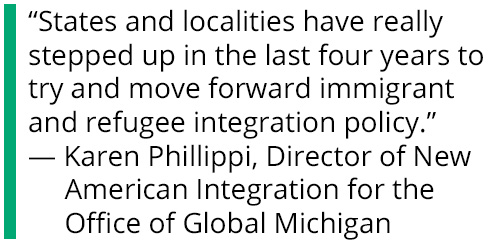
One Republican-led state effort to establish a welcome program for immigrants came by way of an executive order from Michigan Governor Rick Snyder. In January 2014 he created the Michigan Office for New Americans. The name has since changed to the Office of Global Michigan, and Karen Phillippi, who started in the office as a deputy, is now the director of New American Integration. She says, “States and localities have really stepped up in the last four years to try and move forward immigrant and refugee integration policy. That shows that states do have an understanding of their capacity and where their needs are.”
The Office of Global Michigan supports integration at the state level. It provides advice and information to the governor’s office as it relates to immigrant and refugee policy and programs. It also works with state agencies to remove, or at least minimize, barriers to immigrants and refugees accessing state services.
When the Office of Global Michigan was originally established, it was at the height of Detroit’s financial collapse. Governor Snyder and Detroit Mayor Michael Duggan, a Democrat, sent a letter to President Obama essentially asking if visas could be set aside for the city of Detroit to help with revitalization.
“Under the concept of a National Interest Waiver,” Phillippi says, “we wanted to pilot, in the city of Detroit, a program for regionally distressed areas. We said, ‘We came up with the idea, and we’re volunteering to be the first to try it out.’ We were asking for a 10-percent set-aside of unused immigrant visas from other preference categories.”
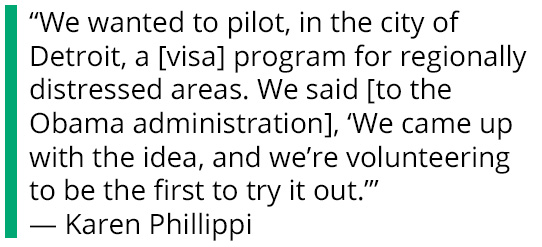
The Obama administration never responded to that letter, so Governor Snyder sent another. “We laid out our argument for why,” she says. “We also talked about how a city would qualify as a regionally distressed area — population loss, poverty rate, crime rate. We did a chart of all the cities (nationwide), and all the larger cities with populations of 500,000 or greater, and what cities could meet these criteria.”
This time they did get a response to the letter; unfortunately it was no. Phillippi says there wasn’t much of a reason given. The response mentioned that the federal government didn’t do pilot programs, even though the Office of Global Michigan gave examples of others.
“The law firm that worked with us,” says Phillippi, “scoured the archives of the immigration service to see if there were any pilot programs in the past, and they had done some nationalization pilots.”
In the end it wasn’t persuasive. “If I had to guess,” says Phillippi, “they didn’t want to, in my words, start this pilot program and set this example that they didn’t know they could do for anybody else.”
Phillippi says they don’t currently have an intention of submitting a similar request to the Biden administration. It’s too early. “I think we still need a little bit more space and time to see what direction things are headed in,” she says. “But there are definitely pieces that we would want to advocate for in terms of the Biden plan for immigration.”
With the idea of a state-sponsored visa program, there are pieces for everyone. As Representative Curtis puts it, “This is hard for people not to like, regardless of the side of this issue that you’re on. It may be a place where we could move forward with just a little bit of fresh ground.”
Read More:
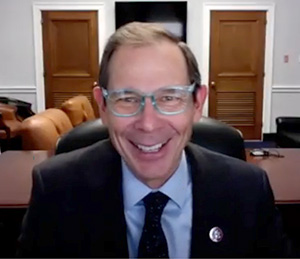
Capitol Hill Briefing No. 1


Strategic Inquiry No. 2


